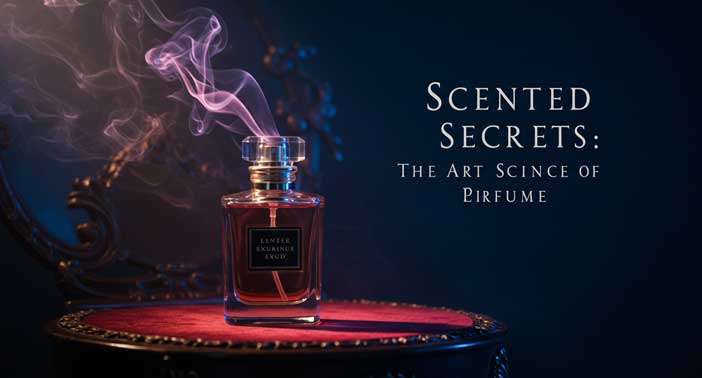SCENTED SECRETS: THE ART & SCIENCE OF PERFUME
Perfume is much more than a mere accessory, it’s an art
form, a history lesson, and a sensory journey all wrapped into one. With roots
stretching back thousands of years, the modern world of fragrance is a blend of
ancient tradition, cutting-edge chemistry, and cultural evolution. In this
feature article, we explore the origins of perfume, unravel the science behind
its complex layers, and offer practical insights for both connoisseurs and
newcomers.
The Origins of Perfume: A Journey Through Time
The very word “perfume” comes from the Latin phrase per
fumum, meaning “through smoke.” This term hints at a fascinating history where
the transformation of incense and aromatic woods into cherished oils set the
stage for a remarkable cultural evolution. Ancient civilizations such as the
Romans and Arabs refined the art of scent over 2500 years ago. Emperor Nero’s
lavish feasts, where rose and jasmine oils were cascaded through ornamental
fountains, demonstrate how perfume was used to create environments of luxury
and excess. Similarly, the Arabian tradition of Bakhoor—a method of burning
incense to scent both clothing and surroundings remains influential today.
Historical Milestones: Pioneers and Firsts
The story of perfume is interwoven with mystery and
innovation. While the identity of the very first perfume remains unknown,
history credits a Babylonian woman named Tapputi as the world’s first recorded
chemist and perfumer. Living around 1200 BCE, Tapputi's early experiments in
scent extraction laid the groundwork for a craft that continues to inspire.
Over time, perfume production evolved from small-scale artisanal practices to
sophisticated, large-scale “factories,” such as the one established 4000 years
ago on Cyprus. The Egyptians, too, revolutionized fragrance by integrating it
into their culture, designing intricate stone and glass vessels to store their
precious scented oils and balms.
The Science Behind the Scent: Notes That Evolve
Ever wondered why your signature scent transforms as the day
unfolds? The answer lies in the carefully crafted layers of perfume top, heart,
and base notes.
•
Top Notes: The initial, delicate burst of fragrance that greets you, but fades
quickly.
•
Heart Notes: The stable, herbal, or floral aromas that define the perfume’s
character and last longer than the top notes.
•
Base Notes: The enduring foundation composed of wood, amber, and musk,
providing depth and longevity to the scent.
These dynamic layers interact with the natural chemistry of
your skin, which is why the same fragrance might smell unique on different
individuals. Factors like skin pH, lifestyle, diet, and environment all
contribute to this personal signature.
Perfume as an Aphrodisiac and Mood Booster
Perfume does much more than simply enhance your personal
scent profile. Certain ingredients, including Jasmine, Ylang ylang, Vanilla,
and Ginger, are noted for their aphrodisiac qualities. Historical figures, such
as Cleopatra, famously harnessed the seductive power of fragrance to entice and
influence. Beyond its alluring properties, perfume acts as a mood enhancer. A
well-chosen fragrance can evoke cherished memories, improve your mood, and
instill confidence transforming an everyday routine into a ritual of
self-expression and empowerment.
Practical Insights: Application, Storage, and
Longevity
Mastering the use of perfume involves both science and art.
Here are key points to keep in mind:
•
Application Techniques:
o
Apply perfume on pulse points wrists, neck, behind the ears, elbows, and behind
the knees where body heat activates and diffuses the scent.
o
Avoid rubbing your wrists together, as friction can alter the fragrance’s
molecular structure.
o
For an extended effect, lightly spritz your hair using a brush instead of
direct application, to prevent drying from the alcohol content.
•
Storage Tips:
o
Perfume is sensitive to temperature fluctuations, humidity, and light. Store
your fragrance upright in a dark, cool place away from the bathroom or car,
which are prone to extreme conditions.
•
Understanding Expiry:
o
Once exposed to air, perfumes evolve with time. Typically, a fragrance should
be enjoyed within 3–5 years to maintain its intended aroma. Higher
concentrations such as pure Parfum tend to preserve their integrity longer than
lighter versions like Eau de Toilette.
•
Concentration Differences:
o
Fragrances are categorized by their concentration of essential oils. Eau de
Toilette contains around 10% perfume oil, Eau de Parfum about 15%, and Parfum
exceeds 20%, leading to longer-lasting scents.
Ethical and Contemporary Considerations
Modern consumers are increasingly conscientious about the
ethical and sustainable aspects of their purchases. While many fragrances
incorporate animal-derived ingredients, an expanding market of vegan and
cruelty-free options is emerging. For those dedicated to ethical consumption,
always check the label and research the brand’s practices. Despite traditional
gender associations in scent profiles, the modern perfume industry embraces
unisex fragrances, encouraging self-expression beyond conventional boundaries.
Conclusion: The Enduring Magic of Perfume
Perfume continues to enchant and influence across cultures
and eras. From its ancient origins in smoky rituals to its refined modern
formulations, fragrance is a multifaceted art form that stimulates the senses,
evokes memories, and fosters personal expression. Whether you’re drawn to the
chemistry of its evolution on your skin, the allure of its historical roots, or
the promise of a mood boost with every spritz, perfume remains an enduring
testament to the blend of science, art, and human emotion.
Embrace the journey of fragrance, discover your signature
scent and let its story become a part of your own.
